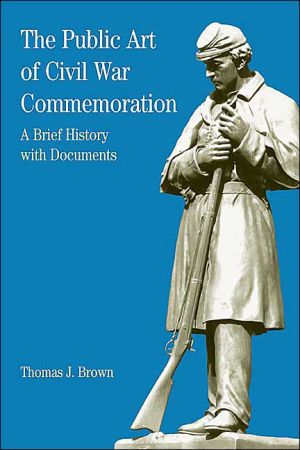

 |

|

The average rating for Public Art of Civil War Commemoration: A Brief History with Documents based on 2 reviews is 3.5 stars.
Review # 1 was written on 2013-09-10 00:00:00 Tori Smith Tori SmithI found this quite enlightening regarding the different forms of remembrance of the Civil War. I've encountered so many 'Soldiers and Sailors Monuments' around the northern US (particularly interesting are ones in Indianapolis and Cleveland), with so many variations in style, that I was curious to learn more. This was very interesting in dissecting these public displays through five lenses (citizen soldiers, the African-American regiment from Massachusetts, Robert E. Lee, women, and Abraham Lincoln.) |
Review # 2 was written on 2015-08-16 00:00:00 Kyle Campbell Kyle CampbellLadies of the Lost Cause Memorials For those interested in how the South memorialized the Civil War and shaped for a long time historical thought on why the war was fought by mythicizing how it was remembered Perdue and past president of The Society of Civil War Historians, Prof. Janney's monograph makes a very good companion volume to David W. Blight's Race and Reunion: The Civil War in American Memory. By examining a select group of Ladies' Memorial Associations (LMAS), she shows how upper class Southern white women attended to the burial of the Confederate dead, paid tribute to the fallen in the first Memorial Day commemorations, and played a major role in propagating the tenets of the Lost Cause effort. In tandem, she illustrates how these women created effective organizations that allowed them to exert political and long lasting historical influence in a fashion resembling a variety of women-driven associations forming nationwide in latter 19th century America. Immediately after the Civil War ended, the victorious North greatly restricted the political activities of white Southern men to the point where any civic act might be considered treason, even burying war dead. White Southern women of privilege filled the gap by forming LMAS. These organizations raised funds from throughout the South to relocate Confederate dead from scattered battlefields (a function performed for the Northern dead by the federal government) to graveyards in or near their hometowns. Janney examines the associations formed in the towns and cities of Winchester (Shenandoah Valley), Fredericksburg, Petersburg, Lynchburg, and Richmond. While LMAS dominated the memorialization of the dead in the early years, after Reconstruction and the rise of Jim Crow, men began to contest the women's authority in the area of memorialization. Too, later in the century, women coalesced into a larger regional organization, the United Daughters of the Confederacy (still today a charitable 501 C organization). Among Janney's points is that Southern white women participated in memorializing their war dead and propagating the cornerstones of Lost Cause long before most historians realized or acknowledged. Lest you think all this nice to know, be aware that the work of the LMAS and the UDC remain with us today, particularly the memorial statuary you can find in towns throughout the South. And what do these memorials symbolize? The Lost Cause, the underlying bedrock of which can be summarized in two words: white supremacy. |
CAN'T FIND WHAT YOU'RE LOOKING FOR? CLICK HERE!!!